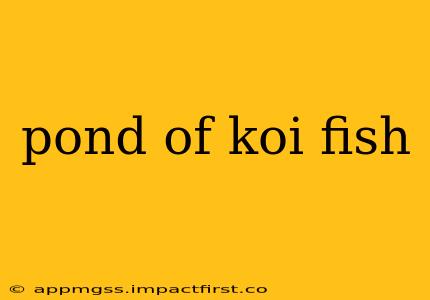Koi ponds are more than just water features; they're living, breathing ecosystems that bring beauty and tranquility to any landscape. Building and maintaining a successful koi pond requires careful planning and ongoing commitment, but the reward of watching these elegant fish thrive is immeasurable. This comprehensive guide will walk you through everything you need to know, from initial design to ongoing care.
What Size Pond Do I Need for Koi Fish?
The size of your pond is crucial for the health and well-being of your koi. A general rule of thumb is to allow at least 1000 gallons of water for every koi you plan to keep. However, larger is always better. Consider the mature size of your koi – some breeds can grow to be quite large! A larger pond provides more space for swimming, reduces stress, and helps maintain better water quality. Overcrowding leads to increased waste, disease, and ultimately, the death of your fish.
How Deep Should a Koi Pond Be?
Depth is another vital consideration. Koi need sufficient depth to protect themselves from extreme temperature fluctuations and predators, especially during winter. A minimum depth of 4 feet is recommended, but deeper is preferable, especially in climates with harsh winters. This deeper water provides a thermal refuge, allowing your koi to survive freezing temperatures.
What Kind of Filter Do I Need for a Koi Pond?
Filtration is the cornerstone of a healthy koi pond. You'll need a robust system capable of handling the bioload generated by your koi. This means removing waste efficiently and keeping the water clean and oxygenated. Several filtration options exist, including:
- Gravity Filters: These utilize gravity to move water through various filter media. They're generally less expensive than pressure filters but may require more maintenance.
- Pressure Filters: These use a pump to force water through the filter media, providing more efficient filtration. They're generally quieter than gravity filters but can be more costly.
- Bottom Drains: Essential for removing solid waste from the pond bottom, preventing it from decomposing and fouling the water. They work in conjunction with your main filter system.
Choosing the right filter depends on the size of your pond and the number of koi. Consulting with a pond specialist is advisable to determine the best system for your needs.
What Plants Are Good for a Koi Pond?
Aquatic plants play a crucial role in maintaining a healthy pond ecosystem. They oxygenate the water, provide shade for your koi, and help prevent algae growth. Consider adding a variety of plants, including:
- Oxygenating Plants: These plants, like hornwort and anacharis, release oxygen into the water, benefiting your fish.
- Marginal Plants: These plants, like water lilies and irises, grow along the edges of the pond, providing visual interest and additional filtration.
The specific plants you choose will depend on your climate and the amount of sunlight your pond receives.
How Often Should I Clean My Koi Pond?
Regular maintenance is key to preventing problems and keeping your koi healthy. This includes:
- Regular Water Testing: Monitor water parameters (ammonia, nitrite, nitrate, pH) regularly.
- Partial Water Changes: Replace a portion of the pond water (about 25%) every few weeks to remove accumulated waste.
- Filter Cleaning: Clean your filter media regularly according to the manufacturer's instructions. Avoid cleaning all the media at once; staggered cleaning helps maintain beneficial bacteria.
- Removing Debris: Remove fallen leaves and other debris from the pond to prevent decomposition and water fouling.
By following these guidelines and staying attentive to the needs of your pond ecosystem, you can create a beautiful and thriving environment for your koi, bringing years of enjoyment to your home. Remember, a healthy pond is a happy pond!
